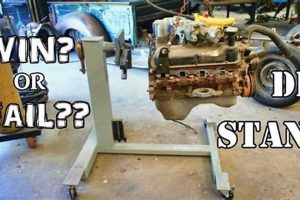A self-constructed support structure designed to hold and stabilize a boat engine not currently attached to a vessel. These structures provide a secure platform for maintenance, repair, storage, and transportation of these engines. An example is a wooden frame built to specified dimensions, allowing an engine to be mounted vertically.
The creation of such a support offers cost savings compared to purchasing a commercially manufactured equivalent. Furthermore, it allows for customization to perfectly match the engine’s size and weight, and available workspace. Historically, such endeavors have been common practice among boat owners and mechanics seeking practical and economical solutions for engine management.
The following sections will explore the considerations involved in constructing a suitable support, including design principles, material selection, and essential safety precautions.
Essential Construction Considerations
Effective construction requires careful planning and execution. The following points are designed to ensure structural integrity, safety, and long-term utility.
Tip 1: Plan for Adequate Load Capacity: The support must be designed to handle the engine’s full weight, plus a safety margin. Consult the engine’s specifications to determine the correct weight and use appropriate materials accordingly. Example: A small 2-stroke engine might require a frame capable of supporting 50 lbs, while a larger 4-stroke could necessitate a 200 lbs capacity or more.
Tip 2: Select Durable and Weather-Resistant Materials: The environment the support will be exposed to significantly impacts material choice. Pressure-treated lumber or steel are viable options, offering resistance to moisture and corrosion. Example: If storage is outdoors, consider galvanized steel to prevent rust.
Tip 3: Ensure a Stable Base: A wide and level base is crucial to prevent tipping. Reinforce the base with additional bracing or leveling feet. Example: Constructing a base with a wider footprint than the engine’s mounting points enhances stability.
Tip 4: Implement Secure Engine Mounting: Design a secure method for attaching the engine to the support. Consider using bolts, clamps, or a combination thereof. Example: Use U-bolts with rubber dampeners to minimize vibration and securely fasten the engine to the frame.
Tip 5: Incorporate Portability Features: Consider adding wheels or handles to facilitate easy movement. Ensure the wheels are lockable to prevent unintended movement during maintenance. Example: Heavy-duty casters with locking mechanisms allow for easy relocation while maintaining stability during operation.
Tip 6: Provide Adequate Clearance: Ensure sufficient clearance around the engine for maintenance and repair. This includes space for tools and access to critical components. Example: Provide at least 12 inches of clearance around the engine for wrench access and adjustments.
These considerations are fundamental to the successful construction of a durable and functional engine support. Proper adherence to these points will contribute to safer and more efficient engine management.
With a solid foundation established, the next step involves exploring advanced design features and optimization strategies.
1. Stability
Stability is a paramount design consideration for a self-constructed engine support. It directly influences the safety of the work environment and the integrity of the engine being serviced or stored. A compromised engine support poses a significant risk of tipping, potentially causing damage to the engine, injury to personnel, or both.
- Base Geometry and Footprint
The dimensions and shape of the support’s base significantly affect its resistance to tipping. A wider base distributes the engine’s weight over a larger area, lowering the center of gravity and enhancing stability. For example, a rectangular base is generally more stable than a square base if the engine’s weight is primarily distributed along the longer axis. A sufficiently large footprint provides inherent resistance to lateral forces that could induce instability.
- Center of Gravity Management
The location of the engine’s center of gravity relative to the support base is critical. Ideally, the center of gravity should be positioned directly above the base’s center. Off-center placement can create a torque that tends to tip the support. Mitigation strategies include widening the base on the side opposite the center of gravity or adding counterweights. Precise engine placement during mounting is therefore essential.
- Material Rigidity and Strength
The materials used in construction must possess adequate rigidity and strength to resist deformation under load. Excessive flexing or bending can compromise stability and lead to catastrophic failure. For example, using undersized lumber or thin-walled steel tubing can result in a support that wobbles or collapses under the engine’s weight. Proper material selection and joint reinforcement are crucial.
- Surface Contact and Friction
The nature of the contact between the support’s base and the supporting surface influences its resistance to sliding. Smooth surfaces offer little resistance, increasing the risk of accidental movement. Conversely, rough or textured surfaces enhance friction and provide a more secure footing. Adding rubber feet or non-slip pads to the base can significantly improve stability, particularly on smooth floors. Careful consideration should be made based on the typical usage environment.
The factors detailed above are essential for constructing a secure and reliable engine support. By carefully considering the geometry, weight distribution, material properties, and surface interactions, a safe support can be realized. A poorly designed engine support is not merely an inconvenience; it presents a genuine safety hazard and a potential source of significant expense.
2. Capacity
Capacity, referring to the load-bearing ability of a self-constructed engine support, is a critical parameter in its design and construction. Improper assessment of the required capacity may lead to structural failure, resulting in potential damage to the engine or injury to personnel.
- Engine Weight Assessment
Accurate determination of the engine’s weight is fundamental to designing an adequate support. Referencing the manufacturer’s specifications or physically weighing the engine provides the necessary data. Overestimation of the weight is preferable to underestimation, providing a safety margin against potential overloading. For instance, if an engine weighs 150 lbs, the support should be designed to withstand at least 200 lbs to account for dynamic loads or unexpected stresses.
- Material Strength and Load Limits
The chosen construction materials must possess sufficient strength to bear the engine’s weight without significant deformation or failure. Wood, steel, and aluminum each have characteristic load-bearing capacities. For example, pressure-treated lumber may be suitable for smaller engines, while steel offers greater strength for larger, heavier models. Published material specifications should be consulted to ensure adherence to safe load limits.
- Structural Design and Reinforcement
The support’s design significantly impacts its ability to distribute and withstand load. Properly placed bracing, gussets, and reinforcement members enhance the structural integrity. A triangular bracing configuration, for instance, provides superior resistance to deformation compared to a simple rectangular frame. Adequate joint connections, using bolts or welding, are also essential for transferring load effectively.
- Dynamic Load Considerations
Static weight is not the sole factor influencing capacity. Dynamic loads, such as those generated during engine handling or transportation, impose additional stress on the support. These loads can be significantly higher than the engine’s static weight. Design considerations should include factors such as acceleration, deceleration, and vibration to ensure the support can withstand these dynamic forces.
The interplay between engine weight, material strength, structural design, and dynamic load considerations determines the overall capacity of a self-constructed engine support. A comprehensive understanding of these elements ensures a safe and reliable platform for engine maintenance, storage, and transportation.
3. Material
Material selection forms a foundational element in the construction of a self-made engine support, directly influencing its strength, durability, and overall suitability for its intended purpose. The choice dictates the support’s longevity and ability to withstand the demands of engine maintenance, storage, and transport.
- Wood – Affordability and Workability
Wood, particularly pressure-treated lumber, offers an economical and readily workable option. Its ease of cutting, shaping, and fastening makes it accessible to builders with basic carpentry skills. However, its susceptibility to moisture, rot, and insect infestation limits its lifespan, especially in outdoor environments. An example is using 4×4 pressure-treated posts for the vertical supports and 2x4s for bracing. The implication is a lower initial cost, but with a potentially shorter service life compared to metal alternatives.
- Steel – Strength and Durability
Steel provides superior strength and resistance to deformation, making it suitable for supporting heavier engines. Its inherent durability allows for long-term use in both indoor and outdoor conditions. However, steel is more challenging to work with, requiring welding or specialized metalworking tools. The potential for rust necessitates protective coatings, such as paint or galvanization. An example is using square steel tubing for the frame, welded together for maximum strength. This translates to higher initial investment but increased longevity and capacity.
- Aluminum – Lightweight and Corrosion Resistance
Aluminum offers a balance between strength and weight, making it easier to maneuver. Its natural resistance to corrosion makes it ideal for marine environments. However, aluminum is generally more expensive than steel and may require specialized welding techniques. An example is constructing a frame from aluminum extrusions connected with bolted brackets. The benefit is reduced weight for portability and resistance to rust in coastal areas, but at a higher material cost.
- Fasteners – Secure Assembly and Load Distribution
The choice of fasteners, such as bolts, screws, or welds, is critical for ensuring a secure and reliable assembly. Fasteners must be appropriately sized and rated to withstand the applied loads. The use of corrosion-resistant fasteners, such as stainless steel, is essential in marine environments to prevent premature failure. An example includes using galvanized bolts and nuts to connect wooden components or employing welding techniques certified for the specific type of steel being used. This ensures the long-term integrity of the assembled structure.
These material considerations illustrate the trade-offs involved in constructing a self-made engine support. The ultimate choice depends on factors such as budget, available tools and skills, the engine’s weight and size, and the intended usage environment. Regardless of the material selected, careful planning and execution are essential for creating a safe and durable structure. Other factors may include combining wood and steel (or aluminum). A builder may use wood for the major structural pieces but then use steel reinforcement for stability and/or protection.
4. Portability
Portability represents a key attribute of a self-constructed engine support, directly impacting its utility and convenience. The ability to relocate the engine, mounted on its support, simplifies maintenance tasks, facilitates storage, and enables transportation. The incorporation of portability features into a self-made engine support directly affects the ease with which engine-related tasks can be performed. For instance, an engine requiring frequent maintenance benefits significantly from being mounted on a support equipped with wheels, allowing it to be easily moved within a workshop or garage. In contrast, a stationary support necessitates moving tools and equipment to the engine’s location, increasing effort and potentially hindering efficient workflow.
The design and implementation of portability features necessitate careful consideration of both weight and terrain. The addition of casters, for example, requires selecting components rated to support the engine’s weight. Furthermore, the caster size and type must be suitable for the surfaces over which the support will be moved. Small casters are appropriate for smooth concrete floors, while larger, pneumatic tires are better suited for uneven or outdoor surfaces. Integrated handles or lifting points also contribute to portability, enabling the support to be loaded onto a truck or trailer for transportation. A practical application involves mechanics who offer mobile repair services: a portable stand allows them to bring the engine, still mounted, to the job site easily, reducing setup time and handling risks.
Ultimately, the level of portability integrated into a self-constructed engine support reflects a trade-off between ease of movement and overall stability. While enhanced portability offers increased convenience, it may also compromise the support’s rigidity and resistance to tipping. Careful engineering and material selection are crucial to striking a balance between these competing objectives. A well-designed portable engine support increases convenience and safety. The choice of whether to focus on portability will depend on the owner’s specific needs and usage expectations.
5. Mounting
Securely attaching the engine to a self-constructed support structure is critical. The integrity of this interface directly affects operational safety and engine stability. Effective mounting design must account for engine weight, vibration, and potential environmental factors.
- Engine Bracket Compatibility
The interface between the engine’s mounting bracket and the support frame requires careful attention. The support frame must accommodate the engine’s mounting points precisely. Mismatches can induce stress and eventual failure. Manufacturers often provide specifications outlining the dimensions and bolt patterns for mounting brackets. Adhering to these ensures proper alignment and load distribution. For example, some engines utilize a four-bolt pattern, while others have a clamping system. The support design must reflect these variations.
- Vibration Dampening Techniques
Engine operation generates significant vibration that can transmit to the support structure and potentially loosen fasteners or cause material fatigue. Implementing vibration dampening techniques is thus crucial. Rubber isolators, for example, placed between the engine bracket and the support frame, absorb vibration and minimize its transmission. The use of locking fasteners, such as Nylock nuts, prevents loosening due to vibration. Properly implemented, these techniques extend the life of both the engine and the support.
- Corrosion Resistance Strategies
Environmental exposure, particularly in marine environments, necessitates corrosion protection. Fasteners and mounting hardware should be constructed from corrosion-resistant materials, such as stainless steel or galvanized steel. Applying protective coatings to the support frame further mitigates corrosion. Regular inspection and maintenance are also vital for identifying and addressing corrosion before it compromises the mounting system. For example, salt spray can rapidly corrode unprotected steel, weakening the connection and potentially causing engine detachment.
- Load Distribution Considerations
The mounting system must distribute the engine’s weight evenly across the support structure. Concentrated loads can create stress points and lead to premature failure. Reinforcing the mounting area with additional supports or gussets distributes the load more effectively. Consider, for instance, using a metal plate to spread the load from the engine’s mounting bolts across a larger surface area on a wooden frame, or using a wider steel plate as the base of the mounting system. Proper load distribution enhances the overall stability and longevity of the support.
The factors detailed above outline the critical aspects of mounting an engine onto a self-constructed support. Proper attention to engine bracket compatibility, vibration dampening, corrosion resistance, and load distribution is vital for creating a safe and reliable system. Failure to address these elements can result in engine damage, structural failure, or potential injury. Secure mounting ensures the longevity and reliability of the entire setup.
6. Clearance
Clearance, in the context of a self-constructed engine support, dictates the available space surrounding the engine. This spatial parameter directly impacts the feasibility of performing maintenance, repairs, and adjustments. Insufficient clearance restricts access to critical components, impeding the ability to effectively service the engine. Conversely, excessive clearance may contribute to a larger, less manageable support structure. Adequate clearance is, therefore, a fundamental design consideration.
The required clearance depends on the specific engine model and the nature of anticipated maintenance tasks. For instance, accessing spark plugs, carburetors, or oil filters necessitates unobstructed space around these components. Similarly, the ability to rotate the engine for inspection or to detach specific parts requires sufficient overhead clearance. Failure to provide adequate clearance may necessitate dismantling portions of the support itself simply to perform routine maintenance, negating the structures primary purpose. As a practical example, consider an engine requiring removal of the lower unit for impeller replacement. Adequate vertical clearance beneath the engine’s mounting bracket is essential to accommodate the lower unit’s removal without obstruction. A real-world scenario demonstrates the practical significance of considering proper clearance. A common instance involves inadequate access to the engine’s drain plug when changing the oil, resulting in spillage and difficulty in performing a routine maintenance task. A poorly designed support, lacking the required clearance, can result in a more difficult and less efficient process.
In conclusion, clearance constitutes a crucial element in the planning and construction of a self-made engine support. It facilitates ease of maintenance and ensures a safer and more efficient work environment. The optimal clearance depends on anticipated maintenance needs and the specific engine model. However, a balance must be struck between accessibility and overall support size to maximize utility without compromising stability and manageability.
Frequently Asked Questions
The following addresses frequently encountered questions regarding the design and construction of self-assembled engine support frameworks.
Question 1: What constitutes an acceptable safety margin when calculating the load capacity of a engine support?
A minimum safety factor of 1.5 is recommended. This means the support should be designed to withstand at least 1.5 times the engine’s stated weight. This accounts for dynamic loads, material imperfections, and unexpected stresses.
Question 2: Are there specific wood types preferable for constructing an engine support intended for outdoor use?
Pressure-treated lumber, specifically wood treated with preservatives suitable for ground contact, is recommended for outdoor applications. This treatment resists rot, decay, and insect infestation, extending the lifespan of the support. Cedar and redwood offer some natural resistance but are generally more expensive.
Question 3: What is the recommended minimum wheel diameter for an engine support intended to be moved across uneven surfaces?
Wheels with a diameter of at least 6 inches are recommended for traversing uneven surfaces. Pneumatic tires provide superior shock absorption and rolling resistance compared to solid wheels, particularly on gravel or grass.
Question 4: How can vibration transmission from the engine to the support structure be effectively minimized?
The use of vibration-dampening mounts, constructed from materials such as rubber or neoprene, is crucial. These mounts isolate the engine from the support frame, reducing vibration transfer and minimizing noise. Consider incorporating resilient washers and lock nuts to further mitigate vibration-induced loosening.
Question 5: What is the best method for preventing galvanic corrosion when using dissimilar metals in a engine support?
Galvanic corrosion occurs when dissimilar metals are in contact in the presence of an electrolyte. To prevent this, utilize sacrificial anodes, such as zinc, to preferentially corrode. Isolating dissimilar metals with non-conductive materials, such as plastic washers or coatings, also reduces the risk of galvanic corrosion.
Question 6: Is welding expertise required to construct a sturdy engine support, or are bolted connections sufficient?
While welding provides superior strength and rigidity, properly designed and executed bolted connections can be sufficient, particularly for smaller engines. Employ high-strength bolts and lock nuts, and ensure adequate overlap between connected components. Regularly inspect bolted connections for loosening and tighten as necessary.
These FAQs provide guidance for ensuring both safe practices and functional utility. Attention to these aspects ensures safety and extended use.
The next section will discuss design schematics and templates.
Conclusion
This exploration of the self-constructed engine support underscored design principles, material selection, and safety measures. Successfully implementing these concepts yields a stable platform for engine maintenance, storage, and transport. This framework enables owners to maintain and manage their engine at minimum expense. The article also highlights the criticality of safety while constructing a diy outboard motor stand, it is a crucial factor to consider.
Careful application of these guidelines empowers engine owners to create a cost-effective, customized solution for their equipment. Prioritizing sound engineering principles and diligent execution ensures the resultant structure reliably serves its intended purpose for the foreseeable future. Constructing a diy outboard motor stand properly and safely would save more budget than buying a brand new one.



![Build a DIY Vertical Bike Stand Today! [Plans & Guide] The DIY Hub: Creative Crafts, Repairs & Life Hacks Build a DIY Vertical Bike Stand Today! [Plans & Guide] | The DIY Hub: Creative Crafts, Repairs & Life Hacks](https://craftingdiycenter.com/wp-content/uploads/2025/07/th-3321-300x200.jpg)



